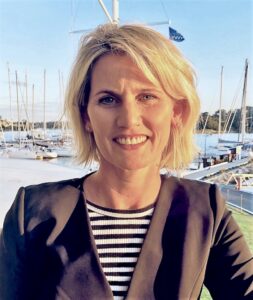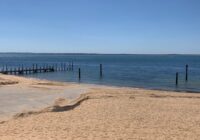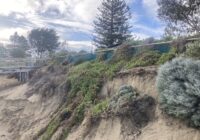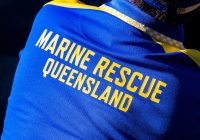By Suzanne Davies, CEO Marina Industries Association
Most yacht clubs in Australia are not-for-profit member organisations and therefore have very different objectives, performance measures and operations to commercially focused marinas, where the ultimate goal is generally to return a profit to the owners.

Sandringham Yacht Club recently upgraded to a 75 tonne Travelift installed by Boatlift.
Club goals are usually guided by the reason the club was originally established. Any surplus funds are required to be reinvested into the objectives of the club, such as the running of sporting competitions, providing children’s training lessons etc. It could be very misleading to compare results of a club with the results of a commercial marina due to the significant differences in their objectives. Clubs should also be very careful in comparing their performance with other clubs, as not only may the objectives be different, but the way in which they are achieved may also be very different.
Most clubs are governed by a volunteer Board of Directors and many of the functions of clubs and their activities are taken on by volunteers. The clubs that are associated with the MIA are generally the larger yacht clubs with marinas and maintenance facilities. The marinas often provide much of the funding required to run the sporting events of clubs (including the purchase of assets such as the support vessels required to run racing and conduct training events). In addition to the sporting functions of clubs, many clubs will support activities and services for their members which would not normally be provided in a commercial operation due to the lack of return. This may include information seminars, historical societies, food and beverage services, fitness centres, and certain boating facilities such as jib cranes, tenders and training fleets.
The 2021 Health of the Australian Industry Survey (HAMIS) provides interesting insights into the differences in the facilities provided by clubs and their performance. Over a quarter of the survey participants were clubs which represents around 50% of the known clubs in the country, so it is fair to say, the data can be considered fairly reliable.
On average, clubs offer more vessel storage and run at higher levels of occupancy than commercial marinas (the table below indicates more than 100 spaces and at least 8% points higher occupancy). Clubs tend to provide other vessel storage options such as hardstands and moorings.

Almost 65% of yacht clubs offered slipping and haul-out services compared with 37% of non-club marinas. A slightly greater proportion of clubs offer fuel service.
84% of clubs organise boat races and 76% provided sailing schools. A further 54% offer boating related educational services and courses. These sporting related services far exceed those of non club marinas. Clubs also tend to provide a broader range of facilities not directly related to boating such as meeting and event facilities (92%), a bar (87%) and restaurants/cafes (78%).
As a consequence of their larger size and broader range of services and facilities on offer, clubs need to employ more staff, operate at high payroll margins and generate significantly higher turnovers ($3.1M) than their commercial counterparts ($2.3M).
Measuring up
To highlight the varying measures used by clubs to benchmark their success, I asked a number of club managers to share their performance measures and here is what I found;
Andy Fethers, CEO of Royal Freshwater Bay Yacht Club, a sailor himself, at four Americas Cups said, “It’s all about active membership. We don’t want boats simply parked in their pens. We wish to avoid being a commercial marina, therefore membership is mandated for berth and hardstand allocations. As a club, we choose to have a focus on sailing, so in alignment with that, yachts will get berthing allocation priority with demonstrated active club participation. Power vessels must do the same and there is a lot of work done around competitions and volunteering for both power and sail. Member boat owners are expected to actively participate in club events on and off water.”
The Cruising Yacht Club of Australia (CYCA) CEO Justine Kirkjian says the most important measures of the success of the club are the size of its yacht racing fleets and overall membership numbers and profiles. “If we have healthy fleets for our inshore and offshore racing programs and there is continued membership growth, the club is inevitably in a strong position – the marina will be well occupied and food and beverage operations trade well. A key focus for the CYCA is member engagement and participation.” The CYCA also has berthing policies for its marina which ensure that owners and their crews actively participate in racing and/or are involved in cruising activities.
Volunteers in clubs are critical to ensure the club’s sporting activities can be maintained. Steve McWhirter from East Fremantle Yacht Club uses his volunteer numbers as a KPI as well as event participation. To ensure they are hitting the financial targets to support the club’s activities, the club also uses metrics such as meals served per day, marina occupancy, social media and website traffic.
Jayson McDonald CMM, CEO of the Royal Motor Yacht Club explains that he measures the satisfaction of his members through member surveys. “It is the most important KPI we measure because of its knock-on effect. If the members are happy, they will use the club and if they are using the club then we are most likely to hit all our other targets.”
Sandringham Yacht Club articulates its goals through its Plan for the Future 2021-2026. Its’ vision is simple, ‘To be Australia’s best yacht club, delivering the ultimate experience in safe, competitive yacht racing, recreational boating, training and social engagement for our members’.
It lists its’ top three 2026 targets as membership satisfaction (95%); boats active in club events (80%) and marina occupancy (98%). CEO, Richard Hewett CMP explains, “For us at Sandy we view member satisfaction as the single most important thing in everything we do. If members are satisfied, then they are more than likely engaged and participating in club events, will want to store their boat at the club, participate in more club activities and consequently, more likely to renew their membership. If they are doing those things, then the financial measures will likely be in good shape. It’s why our target is member satisfaction target is 95%”. Other KPIs that we measure to keep the business on track are financial and include all the normal things like sales, margins, cost of goods etc.”
Interesting across all the clubs, is the reduced focus on profit or financial return. As not for profit organisations clubs primarily exist for other reasons, generally around the promotion of boating as a sport or recreational activity. The beneficial tax arrangements for sports clubs require them to meet a series of ‘tests’ to ensure they are delivering on their boating and sporting charters.
For clubs, financial targets are important, but they are a means to achieving higher order goals which are usually centred around participation in the club’s core on water activities and member satisfaction. While that may sound simple, ask any club manager about the complexities of trying to satisfy several thousand members who all have a different idea of what the club should deliver for them.
Originally published in MIA’s Waterline Magazine – December 2022 issue
For more information about the Marina Industries Association visit www.marinas.net.au

Suzanne Davies
Suzanne is the CEO of the Marina Industries Association, a position she has held since mid-2020 and follows 15 years in senior management roles in the marina industry, including CEO d’Albora Marinas and General Manager of The Royal Prince Alfred Yacht Club. Prior to the marina industries, Suzanne held senior roles in several large domestic and international hotel management companies and enjoyed several years in the education sector as an undergraduate lecturer.
Suzanne was a Director of the MIA 2012- 2020, serving as Treasurer for most of her tenure. She has been a Director on the Board of Australian Sailing since 2019, sits on the Nautilus Marine Insurance Community Grants Program Committee and has recently joined the Seavolt Marine Charging Networks Advisory Board.









